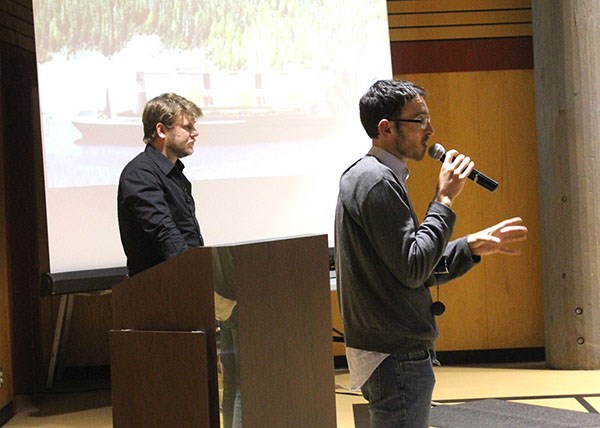In March, hundreds of Squamish residents flocked to Howe Sound’s shoreline to watch a pod of orcas chasing dolphins that were most likely feeding on herring. The public watched in awe and on social media they celebrated the return of marine life to the waterway.
On Friday (June 27) locals attended a gathering of a different sort, but it shared the same focus. Documentary filmmaker Damien Gillis and climate campaigner Eoin Madden presented information at Totem Hall regarding the potential environmental impact of the proposed Woodfibre LNG project on Howe Sound.
The event was organized by My Sea to Sky, a local group formed in March to actively protest what they consider to be unsustainable development proposals within Howe Sound.
Part of My Sea to Sky’s agenda is to provide the public with rational, fact-based arguments that support the environmental protection of Squamish. The information session examined the carefully constructed rhetoric of Christy Clark’s $100 billion LNG Prosperity Fund, which promises to deliver a strong economy and prosperous future for British Columbians.
Gillis, co-founder and publisher of The Common Sense Canadian, questioned the Prosperity Fund’s assertion that projects like the proposed Woodfibre LNG facility will strengthen local economies. He asked attendees to consider how local development of fossil fuel industry will compromise the development of sustainable industries such as recreation, tourism and academia. He added that the introduction of the fossil-fuel industry here may decrease Squamish’s desirability for the many who come here for its natural beauty.
He also referred to research that indicates the retrievable fuel from a drilled well declines by 69 per cent after three years. In the U.S., maintaining the current level of production requires that 7,000 new wells be drilled annually.
Gillis said if the proposed development proceeds, it will result in an increase in the processes required to extract the natural gas from the ground, mostly in northeastern B.C.
B.C.’s LNG industry must compete with countries like Qatar, China, and Russia, who are more experienced in the industry and already selling well below the projected Woodfibre LNG rate.
Madden, a climate campaigner with the Wilderness Committee, described Canada’s investment in the oil and gas industry as a missed opportunity to build economic strength from alternative forms of energy.
“Germany has three times as many jobs in renewable energy than we do in the oil and gas industry,” Madden said. “Canadian graduates are leaving the country to work for clean energy in countries like U.S. and China.”
Madden presented Vancouver Island’s T’Sou-ke Nation as a model for the innovation required to think outside the fossil fuel box. T’Sou-ke Nation’s solar power project supplies the nation’s administration with all of its power requirements, and provides a little extra, which they are able to sell back to the grid for profit.
My Sea to Sky’s increased community education efforts last week coincided with the delivery of a game-changing Tsilhqot’in court decision. The Supreme Court of Canada verdict, widely reported in the media, granted land title to the First Nation, giving them more power to determine whether or not energy projects can occur on their traditional territory.
My Sea to Sky representatives asked those with concerns about the Woodfibre LNG project to write letters to local, provincial, and federal representatives. For more information on My Sea to Sky, visit www.myseatosky.org.



